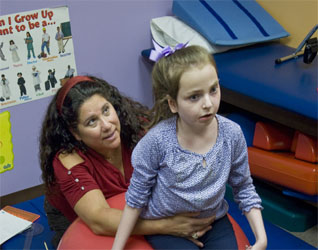Youngest Children at Risk: Easter Seals Report
Easter Seals has released a new report Our Nation’s Children at Risk: A State-by-State Report on Early Intervention during its 2011 International Convention currently being held in Washington, D.C. It was stated today, Nov. 8.
In meetings with Members of Congress on The Hill today, more than 300 Easter Seals volunteers, staff and families with disabilities will share both the report’s findings and a petition with nearly 40,000 signatures urging legislators to invest in young children.
The new report details how well each state takes care of its youngest children with disabilities and delays. The unfortunate news: infants and toddlers in nearly every state continue to fall behind, many will never catch up.
“With the right investment in treatment and therapy before the age of five, we can ensure every child in America can enter school ready to learn,” says Katy Neas, senior vice president, government relations, Easter Seals and Make the First Five Count spokesperson.
[ Also Read: How to Protect Kids from Perils of Social Networking ]While there are many choices for families seeking early identification and early intervention services, the federally funded Individuals with Disabilities Education Act (IDEA), Part C program offers families of children under the age of 3 services designed to help them facilitate their infant or toddler’s development.
It’s a program created to help young children with disabilities or developmental delays catch up with their peers without disabilities, or enhance their development so they can better learn and grow.
In October 2011 the nation celebrated IDEA’s 25th anniversary, yet the legislation has never been fully or adequately funded. Nationally, approximately 2.67 percent of children under the age of three are enrolled in the Part C program.
And yet, data from the National Early Childhood Technical Assistance Center indicates nearly 13 percent of all children under the age of three should be served, using current eligibility criteria. Data from the U.S. Maternal and Child Health Bureau indicate nearly 20 percent of all children could benefit from early identification and early intervention services.
The Easter Seals report highlights some bright spots. States including Massachusetts, Rhode Island, New Mexico, Wyoming, New York and New Hampshire serve more than 4 percent of their population through the Part C program of IDEA.
These six states reach far more children with disabilities and delays than other states, with more young children able to access the critical services and supports they need early in life.
“These states are on the right track, and should serve as an example to others, but we know it’s just the beginning. We have to convince state and federal policy makers about the value of investing in the Part C program,” adds Neas.
This is especially true in states that serve fewer than 2 percent of their population including Georgia, Alabama, Tennessee, Mississippi, Montana, Missouri, Arkansas and the District of Columbia.
Easter Seals created Make the First Five Count to advocate for children at risk for developmental delays or disabilities and ensure they get the support they need to be school-ready and build a foundation for a lifetime of learning. More information is at: MaketheFirstFiveCount.org.
Through Make the First Five Count, Easter Seals is calling on Congress to protect and grow funding for Part C by $100 million, for a total of $539 million, in the years to come.
Easter Seals is the leading non-profit provider of services for individuals with autism, developmental disabilities, physical disabilities and other special needs.





